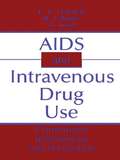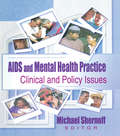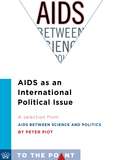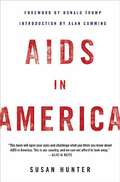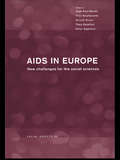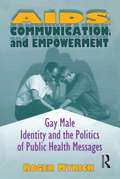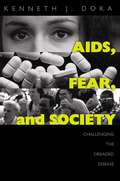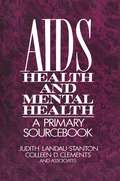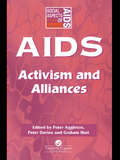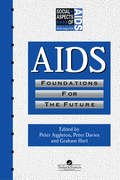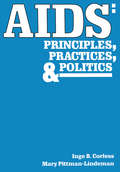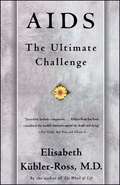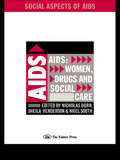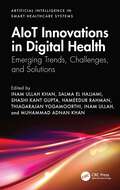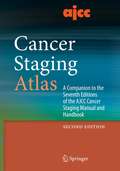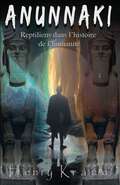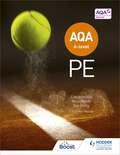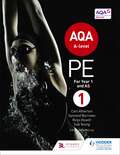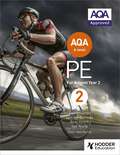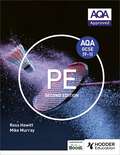- Table View
- List View
AIDS and Intravenous Drug Use: Community Intervention & Prevention
by C. G. Leukefeld Robert J. Battjes Z. AmselFirst published in 1990. Routledge is an imprint of Taylor & Francis, an informa company.
AIDS and Mental Health Practice: Clinical and Policy Issues
by Michael Shernoff R Dennis ShelbyAddressing contemporary issues faced by individuals with HIV/AIDS, AIDS and Mental Health Practice: Clinical and Policy Issues provides psychologists, psychiatrists, social workers, and counselors with research and case studies that offers models for effective clinical practice at this stage of the epidemic. Each chapter is written by experts in the field and demonstrates ways to provide better services to different populations, many of whom are ignored in AIDS and mental health literature. As a result, this book will provide professionals in the field and students in training with the most current practice information about mental health practice and HIV/AIDS. AIDS and Mental Health Practice will help you understand the diverse needs of people with HIV/AIDS and organize services to assist these populations. AIDS and Mental Health Practice discusses issues that affect several different groups in order to help you understand the unique situations of your clients. You will learn how to design treatments that will be most beneficial to Latinos, intravenous drug users, orphaned children, African Americans, HIV-negative gay men, HIV nonprogressors, HIV-positive transsexuals, end-stage AIDS clients, couples of mixed HIV status, and individuals suffering from HIV-associated Cognitive Motor Disorder. This book provides you with approaches that will improve services for these populations, including: talking to patients about the positive and negative aspects of taking protease inhibitors and discussing their feelings of hope, skepticism, and fear of being disappointed by the treatment preparing clients to go back to work by exploring the meaning of work and referring them to vocational services if necessary providing support groups for people living with AIDS (PLWAs), their loved ones, their families, and individuals in bereavement as a result of an AIDS-related death organizing a HIV-negative gay men’s support group that uses exercises and homework to focus on the members’ambivalent connection to the AIDS community, how they remain HIV negative, and ways to deal with separation and grief issues assessing and/or correcting underlying racism in AIDS service organizationsThe prevention and intervention strategies in Mental Health and AIDS Practice will help you address and treat mental health issues associated with HIV/AIDS and offer clients more effective and relevant services.
AIDS as an International Political Issue: A Selection from AIDS Between Science and Politics
by Peter PiotPeter Piot, founding executive director of the Joint United Nations Programme on HIV/AIDS (UNAIDS), reports on the influence of civil society in international relations and traditional partisan divides. AIDS thrust health into national and international politics where, he argues, it rightly belongs. The global reaction to AIDS over the past decade is the positive result of this partnership, showing what can be acheved when science, politics, and policy converge on the ground. Piot describes funding mechanisms for AIDS, the first international declarations, the response of the UN system, the establishment of UNAIDS, the response of high income countries to AIDS, The Global Fund and PEPFAR as game-changers, and lessons for other health problems.
AIDS in America
by Alan Cumming Susan HunterWith more than one million people currently infected and half a million already dead, the U.S. ranks among the top ten most severe AIDS epidemics in the world. Americans should know more about the current state of the epidemic so they can protect themselves and demand that the government act responsibly to reduce the danger of HIV in this country. Hunter exposes the ways in which the U.S. shamefully resembles a developing country, and the many fronts on which the government has failed to control the spread of the disease. In this startling book, she also shows what we must do to change the future of AIDS.
AIDS in Europe: New Challenges for the Social Sciences
by Peter Aggleton Theo Sandfort Jean Paul Moatti Annick Prieur Yves SouteyrandMajor changes in the nature and dynamics of the AIDS epidemic over the last few years are reflected in changing epidemiological trends as well as in the progress made in biomedical research and treatment. AIDS in Europe brings together papers from leading social science researchers to look at the opportunities and challenges these changes bring and the different ways in which they are being responded to in both western and eastern Europe. Papers are organised under three headings: *new challenges for HIV prevention *care of people living with HIV/AIDS in a new therapeutic context *AIDS public policies: from specialisation to normalisation AIDS in Europe provides a comprehensive overview of current social and behavioural research on HIV and AIDS for all health professionals.
AIDS, Communication, and Empowerment: Gay Male Identity and the Politics of Public Health Messages
by Roger MyrickAIDS, Communication, and Empowerment examines the cultural construction of gay men in light of discourse used in the media’s messages about HIV/AIDS--messages often represented as educational, scientific, and informational but which are, in fact, politically charged. The book offers a compelling and substantive look at the social consequences of communication about HIV/AIDS and the reasons for the successes and failures of contemporary health communication. This analysis is important because it provides a reading of health communication from a marginal perspective, one that has often been kept silent in mainstream academic research. AIDS, Communication, and Empowerment offers a critical, historical analysis of public health communication about HIV/AIDS; the ways this communication makes sense historically and culturally; and the implications such messages have for the marginal group which has been most stigmatized as a consequence of these messages. It covers such topics as: the relationship among gay identity, language, and power cultural studies of the historical development of gay identity studies in health communication about HIV/AIDS and health risk communication the political consequences of public health education about HIV/AIDS on gay men the political consequences of media representations of gay identity and its relationship to disease Based primarily on the French scholar Michel Foucault’s critical, historical analysis of discourse and sexuality, this book takes a timely and original approach which differs from traditional, quantitative communication studies. It examines the relationship between language and culture using a qualitative, cultural studies approach which places medicalization theories in the broader context of histories of sexuality, the discursive development of contemporary gay identity, and recent public health communication.Author Roger Myrick explains how mainstream communication about HIV/AIDS relentlessly stigmatizes and further marginalizes gay identity. He describes how national health education stigmatizes groups by associating them with images of disease and “otherness.” Even communication which originates from marginal groups, particularly those relying on federal funds, often participates in linking gay identities with disease. According to Myrick, government funding, while often necessary for the continuation of community-based health campaigns, poses obvious and direct restrictions on effective marginal education. AIDS, Communication, and Empowerment allows for a rethinking of ways marginal groups can take control of their own education on public health issues. As HIV/AIDS cases continue to rise dramatically among marginalized and disenfranchised groups, analysis of health communication directed toward them becomes crucial to their survival. This book provides valuable insights and information for scholars, professionals, readers interested in the relationship among language, power and marginal identity, and for classes in gay and lesbian studies, health communication, or political communication.
AIDS, Fear and Society: Challenging the Dreaded Disease (Death Education, Aging and Health Care)
by Kenneth J. DokaFirst Published in 1997. Routledge is an imprint of Taylor & Francis, an informa company.
AIDS, Health, And Mental Health: A Primary Sourcebook
by Judith Landau-Stanton Colleen D. ClementsThis volume presents a systems approach to understanding and managing the AIDS crisis - an approach that addresses the needs not only of HIV- infected individuals, but also of families and communities at risk from AIDS. Discussions are included on HIV epidemiology and risk reduction, medical management of the AIDS patient, and neuropsychiatric aspects of HIV infection. Strategies for psychotherapeutic intervention, from individual through group to extended family system, are described in detail. The authors examine spiritual, religious and cultural factors in communities and offer guidelines for building a community network for AIDS prevention and intervention. Full consideration is also given to ethical and policy issues, and to the risks faced by health care providers. First published in 1993. Routledge is an imprint of Taylor & Francis, an informa company.
AIDS: Activism And Alliances (Social Aspects of AIDS #Vol. 10)
by Peter Davies Peter Aggleton Graham HartFrom the start of the AIDS epidemic there have been calls for greater solidarity between affected groups and communities, and public health services. This can be seen both in the move towards healthy alliances in health service work, and in the demands of AIDS activists worldwide. This text brings together specially selected papers addressing these and related themes given at the Eighth Conference on Social Aspects of AIDS held in London in late 1995. Among the issues examined are profession and policy; the heightened vulnerability of groups such as women and younger gay men; and issues of drug use, disability and HIV prevention.
AIDS: Foundations For The Future (Social Aspects of AIDS)
by Peter Davies Peter Aggleton Graham HartHIV and AIDS have posed new challenges to societies, communities and individuals. In many parts of the world, existing health and social services have been hard pressed to cope with the dermands of the epidemic. In hospitals and in the community, new approaches to health education, support and care have been developed. Non-governmental and community organizations have had a central role to play in responding to the challenge of HIV and AIDS. AIDS: Foundations for the Future highlights progress made over the last decade, and offers an agenda for future activism and research. This book examines the extent to which sound foundations for the future have been laid in public, private and voluntary sector action. It focuses on topics as diverse as workplace policy on HIV and AIDS, voluntary sector responses, the reactions of health care workers, the experience of living with AIDS, outreach work and community action, patterns of male prostitution, and new interventions to promote and maintain safer sex and safer drug use.
AIDS: Principles, Practices, and Politics (Death Education, Aging and Health Care)
by Inge B. Corless Mary Pittman-LindemanFirst published in 1989. Routledge is an imprint of Taylor & Francis, an informa company.
AIDS: The Ultimate Challenge
by Elisabeth Kubler-Ross"None of us is so unique as to be exempt from the human condition." As the numbers of reported AIDS cases continue to climb, and the disease continues to take more and more lives, those who have to deal with the complexities of this problem continue to ask: "How do we care for these terminally ill?" Using letters from patients, questions and answers between patient and doctor, and other compassionate tools, Dr. Elisabeth Kübler-Ross, the world's foremost expert on death and dying, shows us how to comfort the seriously ill and help AIDS patients through the critical "stages of dying" She addresses the stigma surrounding AIDS as a "gay disease" and makes a special plea for prisoners with AIDS, for women and children with AIDS, and for babies with AIDS. This remarkable book is warm and informative on one of the most important subjects of our time.
AIDS: Women, Drugs And Social Care (Social Aspects of AIDS #Vol. 1)
by Nicholas Dorn Sheila Henderson Nigel SouthExamines the circumstances, experiences and needs of HIV-positive people in Britain and Ireland, and particularly focuses on female drug-users and ex drug-users.
AIoT Innovations in Digital Health: Emerging Trends, Challenges, and Solutions (Artificial Intelligence in Smart Healthcare Systems)
by Inam Ullah Khan Shashi Kant Gupta Inam Ullah Salma El Hajjami Hameedur Rahman Thiagarajan Yogamoorthi Muhammad Adnan KhanArtificial Intelligence (AI) innovations in digital health offer unprecedented opportunities to facilitate human health and provide tools and techniques that reduce overall costs. This book discusses the use of AI to improve diagnostic accuracy, patient monitoring, the use of remote diagnostic tools, identification of life-threatening diseases, medical robotics applications, drug discovery, technology-driven solutions, and much more.AIoT Innovations in Digital Health: Emerging Trends, Challenges, and Solutions presents integrated technologies such as Green Computing, IoT, and Big Data using AI, Machine Learning, Deep Learning, and Federated Learning for Healthcare. It discusses the future of medical robotics using Machine Learning and highlights the use of Federated Learning-based patient monitoring applications. This book also elaborates on the role that AI and Machine Learning play in drug discovery.Interested readers will include anyone working in or involved in smart healthcare research which includes, but is not limited to, healthcare specialists, computer science engineers, electronics engineers, systems engineers, and pharmaceutical practitioners.
AJCC Cancer Staging Atlas: A Companion to the Seventh Editions of the AJCC Cancer Staging Manual and Handbook
by Alexander Olawaiye Scott H. Kurtzman Julio Garcia-Aguilar David R. Byrd Carolyn C. Compton Mary Kay WashingtonSignificantly expanded, expertly and beautifully illustrated, The AJCC Cancer Staging Atlas, 2nd Edition, offers more than 600 illustrations created exclusively for this new edition and is fully updated to reflect the concepts discussed in the 7th Edition of both the AJCC Cancer Staging Manual and its companion Handbook. This Atlas illustrates the TNM classifications of all cancer sites and types included in the 7th Edition of the Manual and visually conceptualizes the TNM classifications and stage groupings. Specifically designed for simplicity and precision, the drawings have been verified through multi-disciplinary review to ensure accuracy and relevancy for clinical use. Every illustration provides detailed anatomic depictions to clarify critical structures and to allow the reader to instantly visualize the progressive extent of malignant disease. In addition, nodal maps are included for each site, appropriate labeling has been incorporated to identify significant anatomic structures, and each illustration is accompanied by an explanatory legend. The AJCC Cancer Staging Atlas, 2nd Edition, is an official publication of the American Joint Committee on Cancer, the recognized international leader in state-of-the-art information on cancer staging. This Atlas has been created as a companion to the updated 7th Edition of the AJCC Cancer Staging Manual, which continues to disseminate the importance of anatomical and pathological staging in the management of cancer. This state-of-the-art, invaluable 2nd Edition includes a CD containing PowerPoint slides of all illustrations, additional color, and a user-friendly, easy-to-read layout. The AJCC Cancer Staging Atlas, 2nd Edition will serve as an indispensable reference for clinicians, registrars, students, trainees, and patients.
ANUNNAKI: Reptiliens dans l’histoire de l’humanité
by Robinson FowlerIl y a beaucoup de cultures qui nous parlent de l’existence d’êtres Reptiliens, considérés comme des dieux: Les Anunnakis. Il y a beaucoup d’indices, de traces que ces êtres ont laissé dans notre histoire. Les anciens signalèrent et représentèrent ces dieux dans leurs peintures, leurs écrits, et surtout, leurs constructions, lesquelles sont impossibles à reproduire aujourd’hui. Leurs connaissances tant technologiques que de conscience de l’univers influencèrent notre histoire... même jusqu’à nos jours...
AQA A-level PE (Year 1 and Year 2)
by Sue Young Ross Howitt Carl AthertonBoost confidence with our all-in-one textbook for AQA A-level Physical Education. This updated and accessible textbook combines Year 1 and Year 2 content with brand new assessment preparation to provide detailed support for both the academic and practical elements of the course. This book:- Develops conceptual understanding with thorough coverage of topics on the AQA A-level specification together in one book- Includes updates to 'end of chapter practice' questions and assessment preparation- Contains summaries, diagrams and key questions to direct thinking and aid revision- Stretches, challenges and encourages independent thinking and a deeper understanding through extension questions, stimulus material and suggestions for further reading- Features definitions of key terms to aid and consolidate understanding of technical vocabulary and concepts- Builds sound knowledge and understanding, analysis, evaluation and application skills through activitiesThis Student Book has been approved by AQA
AQA A-level PE (Year 1 and Year 2)
by Sue Young Ross Howitt Carl AthertonBoost confidence with our all-in-one textbook for AQA A-level Physical Education. This updated and accessible textbook combines Year 1 and Year 2 content with brand new assessment preparation to provide detailed support for both the academic and practical elements of the course. This book:- Develops conceptual understanding with thorough coverage of topics on the AQA A-level specification together in one book- Includes updates to 'end of chapter practice' questions and assessment preparation- Contains summaries, diagrams and key questions to direct thinking and aid revision- Stretches, challenges and encourages independent thinking and a deeper understanding through extension questions, stimulus material and suggestions for further reading- Features definitions of key terms to aid and consolidate understanding of technical vocabulary and concepts- Builds sound knowledge and understanding, analysis, evaluation and application skills through activitiesThis Student Book has been approved by AQA
AQA A-level PE Book 1: For A-level year 1 and AS
by Symond Burrows Sue Young Ross Howitt Carl AthertonExam Board: AQALevel: AS/A-levelSubject: PEFirst Teaching: September 2016First Exam: June 2017Inspire, motivate and give confidence to your students with AQA PE for A Level Book 1. This reliable and accessible textbook will offer your students comprehensive support for both the academic and practical elements of the course.This Student's Book has been selected for AQA's official approval process.- Key questions to direct thinking and help students focus on the key points- Diagrams to aid understanding- Summaries to aid revision and help students access the main points - Extension questions, stimulus material and suggestions for further reading to stretch, challenge and encourage independent thinking and a deeper understanding - Definition of key terms - again to aid and consolidate understanding of technical vocabulary and concepts- Activities to build conceptual understanding and sound knowledge and understanding, analysis, evaluation and application skillsContents:Section 1 Applied Anatomy and Physiology 1.1 The cardiovascular system (Sue Young)1.2 The respiratory system (Sue Young)1.3 The neuromuscular system (Sue Young)1.4 The musco-skeletal system and analysis of movement in physical activities (Sue Young)Section 2 Skill acquisition 2.1 Skill acquisition (Carl Atherton)2.2 Principles and theories of learning and performance (Carl Atherton)Section 3 Sport and society 3.1 Emergence of globalization of sport in the 21st century (Symond Burrows)3.2 The impact of sport on society and of society on sport (Symond Burrows)Section 4 Exercise physiology 4.1 Diet and nutrition and their effect on physical activity and performance (Sue Young)4.2 Preparation and training methods in relation to maintaining physical activity and performance (Sue Young)Section 5 Biomechanical movement 5.1 Biomechancial principles and levers (Sue Young)Section 6 Sport psychology 6.1 Physiological influences on the individual (Carl Atherton)6.2Further psychological effects on the individual (Carl Atherton)6.3 Psychological influences on the team (Carl Atherton)Section 7 The role of technology in physical activity and sport 7.1 The role of technology in physical activity and sport (Symond Burrows)Section 8 Assessment 8.1 Tackling the AS exam (Ross Howitt)8.2 Tackling the non-examined assessment (Ross Howitt)
AQA A-level PE Book 1: For A-level year 1 and AS
by Symond Burrows Sue Young Ross Howitt Carl AthertonExam Board: AQALevel: AS/A-levelSubject: PEFirst Teaching: September 2016First Exam: June 2017Inspire, motivate and give confidence to your students with AQA PE for A Level Book 1. This reliable and accessible textbook will offer your students comprehensive support for both the academic and practical elements of the course.This Student's Book has been selected for AQA's official approval process.- Key questions to direct thinking and help students focus on the key points- Diagrams to aid understanding- Summaries to aid revision and help students access the main points - Extension questions, stimulus material and suggestions for further reading to stretch, challenge and encourage independent thinking and a deeper understanding - Definition of key terms - again to aid and consolidate understanding of technical vocabulary and concepts- Activities to build conceptual understanding and sound knowledge and understanding, analysis, evaluation and application skillsContents:Section 1 Applied Anatomy and Physiology 1.1 The cardiovascular system (Sue Young)1.2 The respiratory system (Sue Young)1.3 The neuromuscular system (Sue Young)1.4 The musco-skeletal system and analysis of movement in physical activities (Sue Young)Section 2 Skill acquisition 2.1 Skill acquisition (Carl Atherton)2.2 Principles and theories of learning and performance (Carl Atherton)Section 3 Sport and society 3.1 Emergence of globalization of sport in the 21st century (Symond Burrows)3.2 The impact of sport on society and of society on sport (Symond Burrows)Section 4 Exercise physiology 4.1 Diet and nutrition and their effect on physical activity and performance (Sue Young)4.2 Preparation and training methods in relation to maintaining physical activity and performance (Sue Young)Section 5 Biomechanical movement 5.1 Biomechancial principles and levers (Sue Young)Section 6 Sport psychology 6.1 Physiological influences on the individual (Carl Atherton)6.2Further psychological effects on the individual (Carl Atherton)6.3 Psychological influences on the team (Carl Atherton)Section 7 The role of technology in physical activity and sport 7.1 The role of technology in physical activity and sport (Symond Burrows)Section 8 Assessment 8.1 Tackling the AS exam (Ross Howitt)8.2 Tackling the non-examined assessment (Ross Howitt)
AQA A-level PE Book 2: For A-level year 2
by Symond Burrows Ross Howitt Carl AthertonExam Board: AQALevel: AS/A-levelSubject: PEFirst Teaching: September 2016First Exam: June 2018Inspire, motivate and give confidence to your students with AQA PE for A Level Book 2. This reliable and accessible textbook will offer your students comprehensive support for both the academic and practical elements of the course.This Student's Book has been selected for AQA's official approval process.- Key questions to direct thinking and help students focus on the key points- Diagrams to aid understanding- Summaries to aid revision and help students access the main points - Extension questions, stimulus material and suggestions for further reading to stretch, challenge and encourage independent thinking and a deeper understanding - Definition of key terms - again to aid and consolidate understanding of technical vocabulary and concepts- Activities to build conceptual understanding and sound knowledge and understanding, analysis, evaluation and application skillsContents:Section 1 Applied Anatomy and Physiology - Sue Young1.1 Energy systemsSection 2 Skill acquisition - Carl Atherton2.1 Information processingSection 3: Exercise physiology - Sue Young3.1 Injury prevention and the rehabilitation of injury Section 4: Biomechanical movement - Sue Young4.1 Linear motion4.2 Angular motion4.3 Projectile motion4.4 Fluid mechanicsSection 5: Sport psychology - Carl Atherton5.1 Psychological factors that can influence an individual in physical activities Section 6 Sport and society and the role of technology in physical activity and sport - Symond Burrows6.1 Concepts of physical activity and sport6.2 Development of elite performers in sport6.3 Ethics in sport6.4 Violence in sport6.5 Drugs in sport6.6 Sport and the law6.7 Impact of commercialisation on physical activity and sport and the relationship6.8 The role of technology in physical activity and sport Section 7 Assessment - Ross Howitt7.1 Tackling the A-level exam7.2 Tackling the non-examined assessment
AQA A-level PE Book 2: For A-level year 2
by Symond Burrows Sue Young Ross Howitt Carl AthertonExam Board: AQALevel: AS/A-levelSubject: PEFirst Teaching: September 2016First Exam: June 2018Inspire, motivate and give confidence to your students with AQA PE for A Level Book 2. This reliable and accessible textbook will offer your students comprehensive support for both the academic and practical elements of the course.This Student's Book has been selected for AQA's official approval process.- Key questions to direct thinking and help students focus on the key points- Diagrams to aid understanding- Summaries to aid revision and help students access the main points - Extension questions, stimulus material and suggestions for further reading to stretch, challenge and encourage independent thinking and a deeper understanding - Definition of key terms - again to aid and consolidate understanding of technical vocabulary and concepts- Activities to build conceptual understanding and sound knowledge and understanding, analysis, evaluation and application skillsContents:Section 1 Applied Anatomy and Physiology - Sue Young1.1 Energy systemsSection 2 Skill acquisition - Carl Atherton2.1 Information processingSection 3: Exercise physiology - Sue Young3.1 Injury prevention and the rehabilitation of injury Section 4: Biomechanical movement - Sue Young4.1 Linear motion4.2 Angular motion4.3 Projectile motion4.4 Fluid mechanicsSection 5: Sport psychology - Carl Atherton5.1 Psychological factors that can influence an individual in physical activities Section 6 Sport and society and the role of technology in physical activity and sport - Symond Burrows6.1 Concepts of physical activity and sport6.2 Development of elite performers in sport6.3 Ethics in sport6.4 Violence in sport6.5 Drugs in sport6.6 Sport and the law6.7 Impact of commercialisation on physical activity and sport and the relationship6.8 The role of technology in physical activity and sport Section 7 Assessment - Ross Howitt7.1 Tackling the A-level exam7.2 Tackling the non-examined assessment
AQA A-level PE Book 2: For A-level year 2
by Symond Burrows Sue Young Ross Howitt Carl AthertonExam Board: AQALevel: AS/A-levelSubject: PEFirst Teaching: September 2016First Exam: June 2018Inspire, motivate and give confidence to your students with AQA PE for A Level Book 2. This reliable and accessible textbook will offer your students comprehensive support for both the academic and practical elements of the course.This Student's Book has been selected for AQA's official approval process.- Key questions to direct thinking and help students focus on the key points- Diagrams to aid understanding- Summaries to aid revision and help students access the main points - Extension questions, stimulus material and suggestions for further reading to stretch, challenge and encourage independent thinking and a deeper understanding - Definition of key terms - again to aid and consolidate understanding of technical vocabulary and concepts- Activities to build conceptual understanding and sound knowledge and understanding, analysis, evaluation and application skillsContents:Section 1 Applied Anatomy and Physiology - Sue Young1.1 Energy systemsSection 2 Skill acquisition - Carl Atherton2.1 Information processingSection 3: Exercise physiology - Sue Young3.1 Injury prevention and the rehabilitation of injury Section 4: Biomechanical movement - Sue Young4.1 Linear motion4.2 Angular motion4.3 Projectile motion4.4 Fluid mechanicsSection 5: Sport psychology - Carl Atherton5.1 Psychological factors that can influence an individual in physical activities Section 6 Sport and society and the role of technology in physical activity and sport - Symond Burrows6.1 Concepts of physical activity and sport6.2 Development of elite performers in sport6.3 Ethics in sport6.4 Violence in sport6.5 Drugs in sport6.6 Sport and the law6.7 Impact of commercialisation on physical activity and sport and the relationship6.8 The role of technology in physical activity and sport Section 7 Assessment - Ross Howitt7.1 Tackling the A-level exam7.2 Tackling the non-examined assessment
AQA GCSE (9-1) PE Second Edition
by Mike Murray Ross HowittWritten by leading PE specialists, students will be guided through the AQA GCSE (9-1) PE specification topic by topic and have opportunity to improve their understanding, analysis, evaluation and application skills through exam-style questions and detailed insight to the NEA.Approved by AQA, this Student Book:- develops understanding with thorough coverage of topics and contains summaries, diagrams and key questions to direct thinking and aid revision- provides clear definitions of key terms, technical vocabulary and concepts, including those that students have struggled the most- builds sound knowledge and analysis, evaluation and application skills through detailed support and exam-style questions- stretches, challenges and encourages independent thinking and a deeper understanding through activities, stimulus material and suggestions for further reading.
AQA GCSE (9-1) PE Second Edition
by Mike Murray Ross HowittWritten by leading PE specialists, students will be guided through the AQA GCSE (9-1) PE specification topic by topic and have opportunity to improve their understanding, analysis, evaluation and application skills through exam-style questions and detailed insight to the NEA.Approved by AQA, this Student Book:- develops understanding with thorough coverage of topics and contains summaries, diagrams and key questions to direct thinking and aid revision- provides clear definitions of key terms, technical vocabulary and concepts, including those that students have struggled the most- builds sound knowledge and analysis, evaluation and application skills through detailed support and exam-style questions- stretches, challenges and encourages independent thinking and a deeper understanding through activities, stimulus material and suggestions for further reading.
